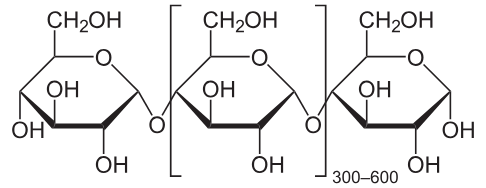Polysaccharides
1/14
There's no tags or description
Looks like no tags are added yet.
Name | Mastery | Learn | Test | Matching | Spaced |
|---|
No study sessions yet.
15 Terms
polysaccharides
made up of many monosaccharides
convenient storage molecules
insoluble
being, large, not likely to move out of cells
fold easily into compact shapes
easily hydrolyzed
chemically inert
no osmotic effect
pectin
middle lamella
hemicelluloses
cell walls of plants
peptidoglycan
cell walls of bacteria
chitin
occurs in fungal cell walls
lignin
found in wall of xylem
glycoproteins/glycolipids
found on cell membranes and allows recognition of cells
cellulose
polymer b-glucose
b 1,4 glycosidic - difficult to hydrolyze
linear chains due to hydrogen bonds between OH (why they’re pronouced)
cellulose chains in groups to form microfibrils and then macrofibrils so have high tensile strength
allows plants to become turgid

Starch
polymer of alpha glucose
food store in plants
forms from two polysaccharides amylose and amylopectin.
Amylose
alpha- glucose
many unbranched linear chains
alpha 1-4, glycosidic linkages causing the chain to oil

Amylopectin
polymer of alpha glucose
branched molecules.
alpha 1,4 glycosidic linkages and alpha 1,6
Test for starch
iodine
turns blue black
Glycogen
polymer of alpha- glucose
stored by animals in liver and muscle and fungi
alpha 1,4 and alpha 1,6
frequent side branches increase SA to break it down into glucose
2 structural similarities and differences between glycogen and starch
similar; both have alpha glucose monomers, both 1-4 and 1-6
differences; starch has amylose and amylopectin glycogen doesnt, glycogen is more branched